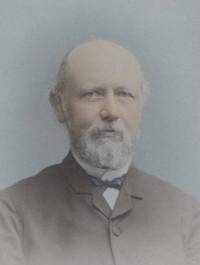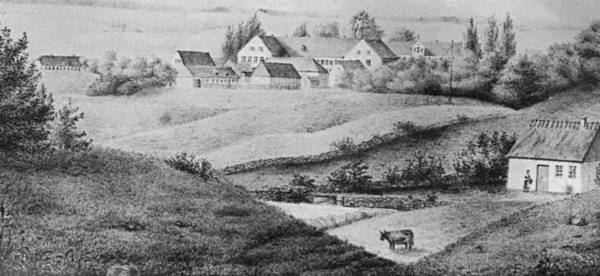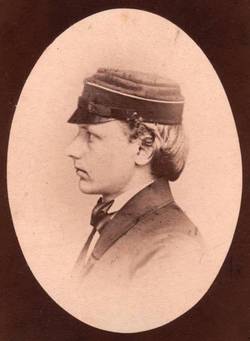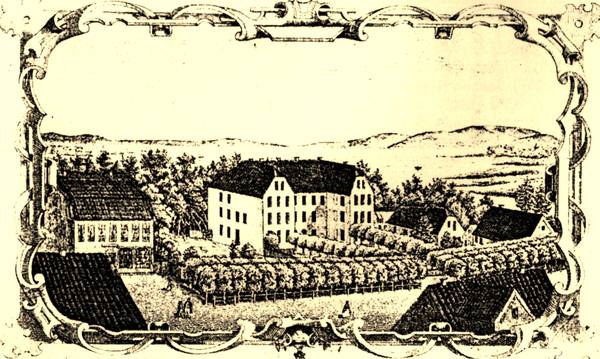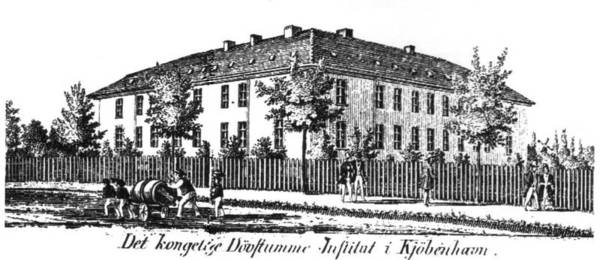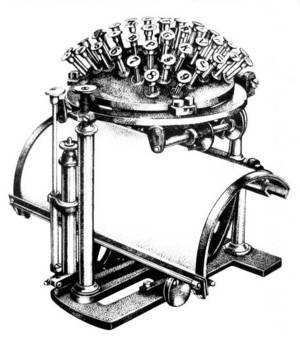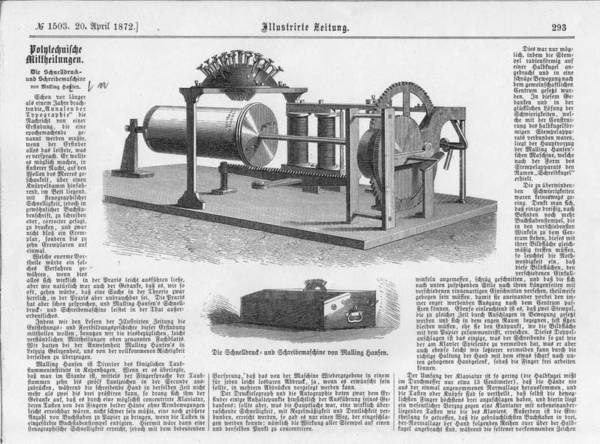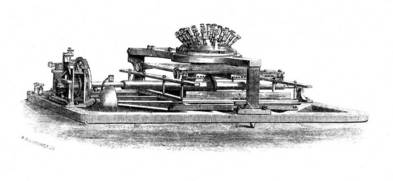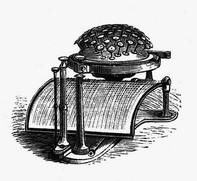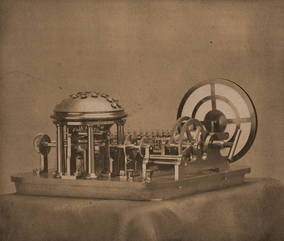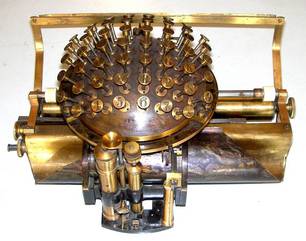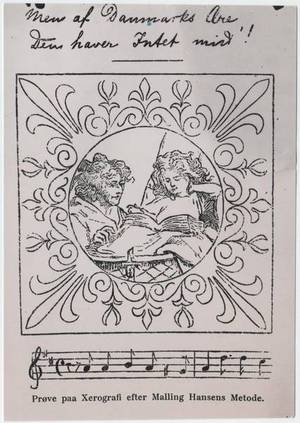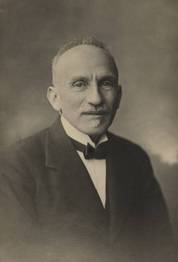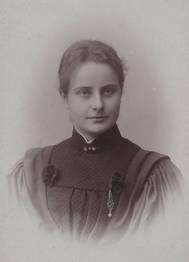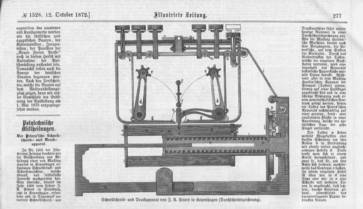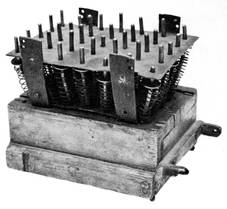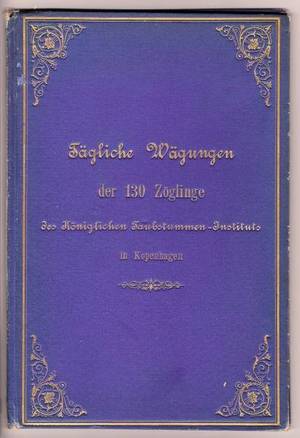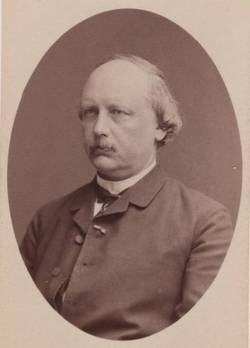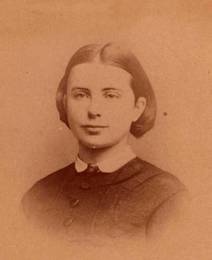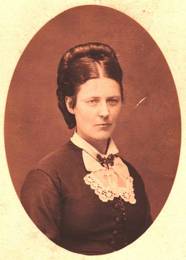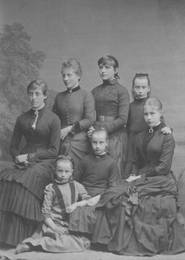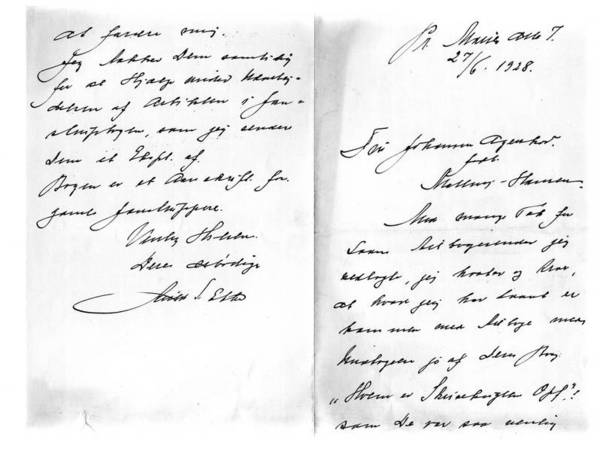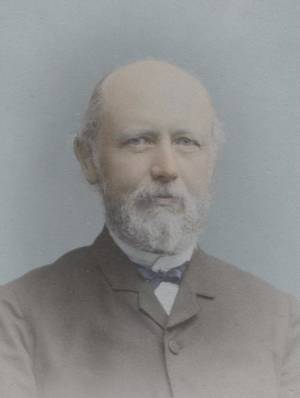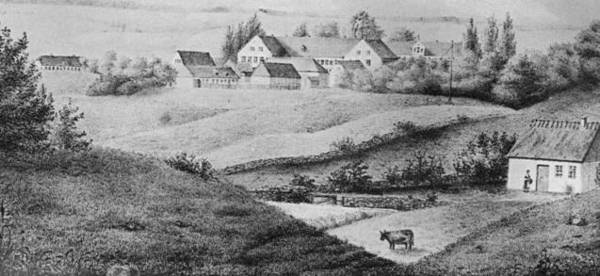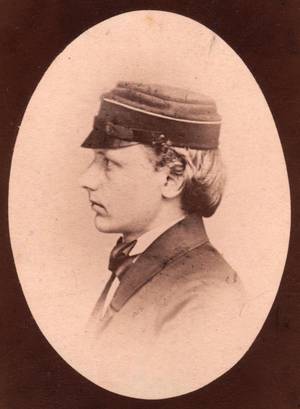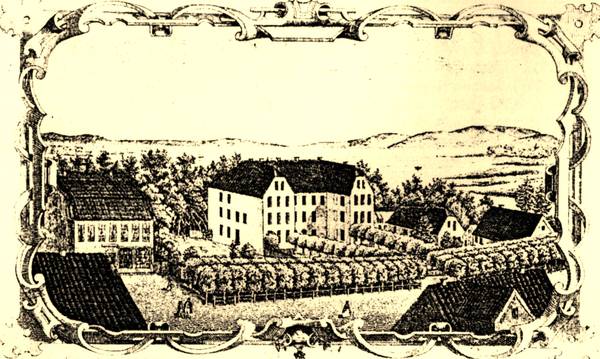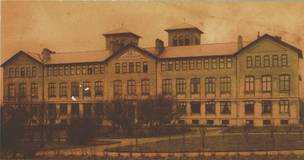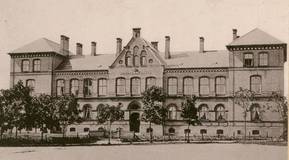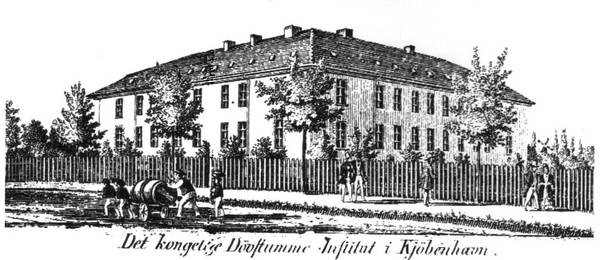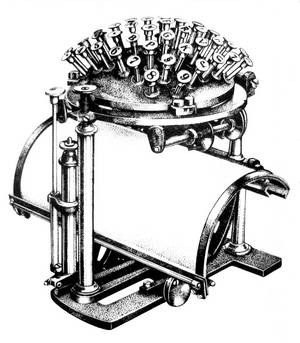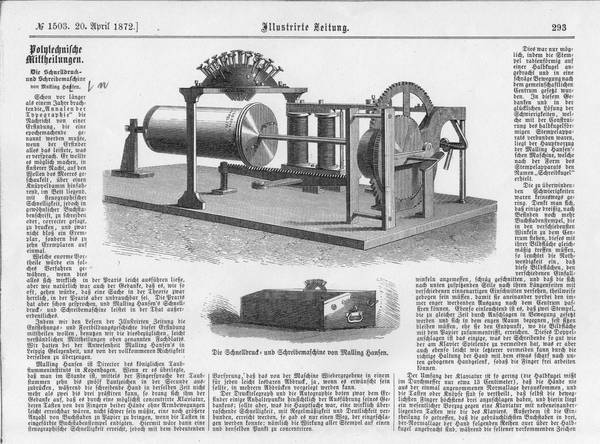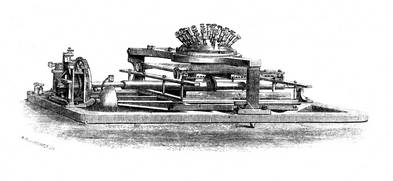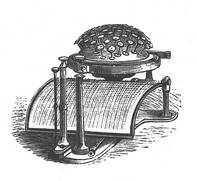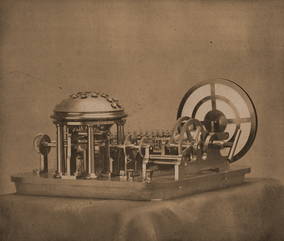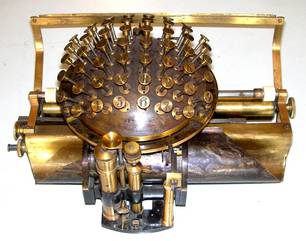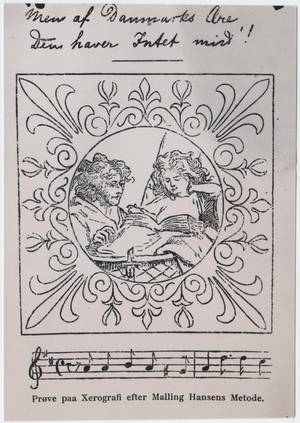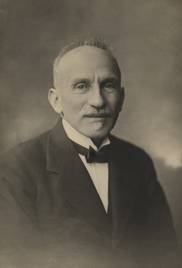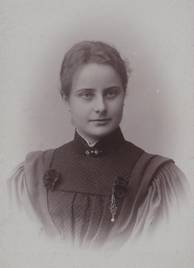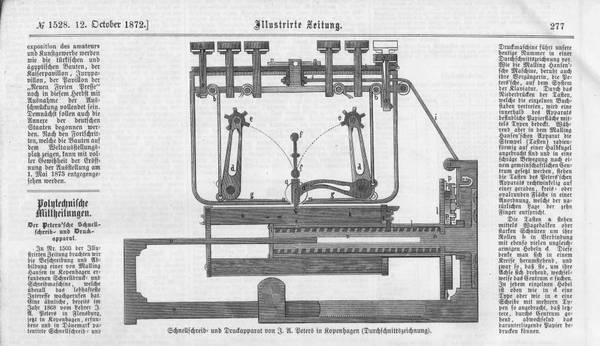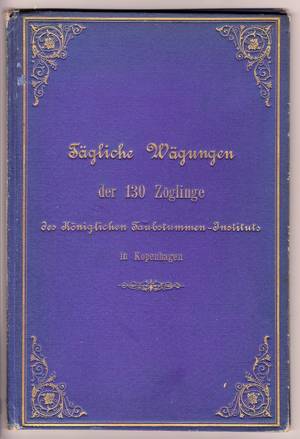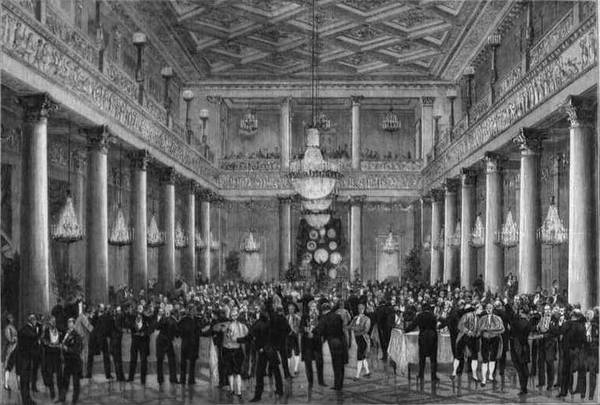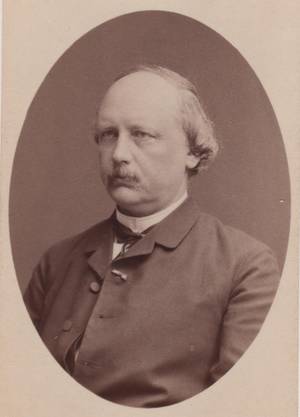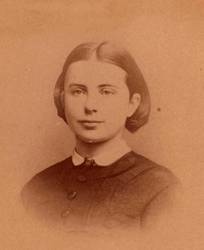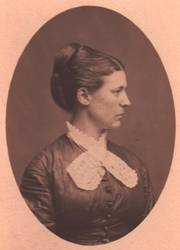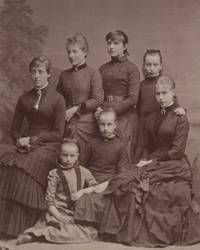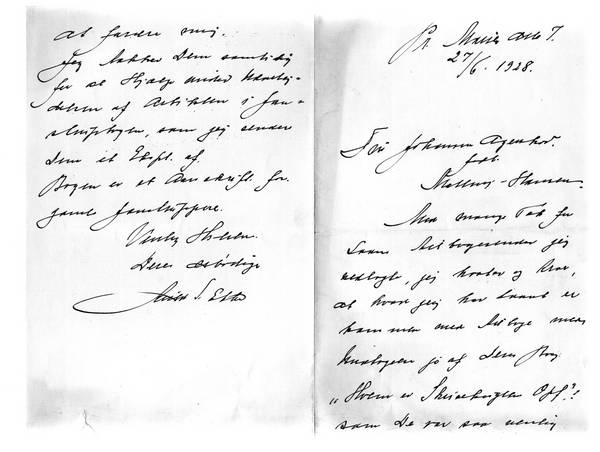Malling-Hansen Biography by Arild S. Ebbe
Transcription, comments and illustrations by Sverre Avnskog. Translation and additional footnotes by Jørgen Malling Christensen.
This biography by Arild S. Ebbe was included in the ”Jonstrup Book” from 1928. Unfortunately we have few personal data about Arild Ebbe, but he is mentioned in the register of ”members of the Jonstrup Society” with the following information:
”Ebbe, A.S., year of graduation: 1910, position: T (i.e. teacher) and address: Prinsesse Maries Allé 7, Copenhagen K.” At any rate, it is certain that Ebbe had very deep knowledge about the life of Rasmus Malling-Hansen; among other things, he quotes a speech given by Malling-Hansen shortly before his death at the centenary jubilee of the Jonstrup Teacher Training College – August 4, 1890. Arild S. Ebbe writes Malling-Hansen’s name without the hyphen – the way he himself wrote it until around about 1882-83, when he began to use a hyphen consistently: Malling-Hansen. Originally, “Malling” was part of his given names, since he was named after his foster father ( who was also the foster father of his mother!), Rasmus Malling, and was baptized Hans Rasmus Malling Johan Hansen.
Malling Hansen
By Arild S. Ebbe
“The conditions of a tiny country and its inherent scepticism; the confined space in this country; the feeling of being stuck in a small creek, while the big waves were thundering outside in the distance, weighed down this man.
Like so many others he started out in a dauntless spirit, in his vivid imagination picturing all impediments cleared away; but time passed and he learned the proverbial lessons about the thorny path to honour and glory. He believed himself able to advance by leaps and bounds, but soon enough learned that the journey shall be measured at a snail’s pace. He imagined the erection of a statue but managed only a torso”. This is what “Illustrated Journal” wrote on the occasion of Malling Hansen’s death in 1890.
They were probably right; and yet, Malling Hansen achieved a lot. He invented the writing ball, the tachygraf and the xerography – had the stature of an excellent biologist and died – only 55 years old – as principal and pastor of the Royal Institute for the Deaf-Mute in Copenhagen.
On his life-journey he did have periods of sunshine, and we also cannot claim that he encountered dogged resistence, however he was often met with indifference, where he had hoped to find a warm reception, reticence where he had hoped for full approval. People did not believe him all together, only listened with half an ear and were willing to venture only little.
Hans Rasmus Johan Malling Hansen – who used to sign as R.Malling Hansen – was born September 5, 1835 in Hunseby, Lolland. His father, Johan Frederik Hansen, was a teacher at Havlykke, his mother was Juliane Cathrine, née Matzen. After the early death of the father (1839) he was adopted as foster son by the remarkably cultivated and skilled school teacher Rasmus Malling in Hunseby. (Rasmus Malling graduated from Jonstrup Teacher Training College in 1808 and was employed the same year as a teacher at Hunseby). In his foster father – from whom he took the name Malling – he acquired the first impressions from the wide world outside, and the urge to be someone and achieve greatness was awakened in him. The bright and energetic child, who had many different talents, was, however, when he reached suitable age, put into apprenticeship to become a house painter in Maribo, since the financial circumstances did not allow for his further academic studies, and hence he had to abandon, at that stage, his youthful dreams.
But then a “deus ex machina” showed up – Count Knuth of Knuthenborg Manor – who had heard about the bright lad, and by his support he was able to enrol at Jonstrup Teacher Training College, from which he graduated in 1854 after three years with a top grade of “excellent”.
The Jonstrup Period
He would always refer to his residence at Jonstrup with the greatest love and gratitude; feelings which he expressed so very beautifully in his speech at the college centenary celebrations on August 4, 1890.
Actually, the official celebration was June 25 – i.e. the centenary day of the execution of the royal ordinance – but certain circumstances, and among them the fact that the big Nordic meeting for teachers and educators was held this year in Copenhagen in early August, led to a situation where 43 former pupils and with Malling Hansen as chairman – at the time principal of the Royal Institute for the deaf-mute - sent invitations for a celebration party on August 4.
Around 200 former pupils showed up, and after lecturer Betz, from Idestrup, Falster, had spoken in honour of the King, Malling Hansen was given the floor to speak for “old Jonstrup, all participants of this celebration and in particular all of you brothers, sons of the old Jonstrup”, and he spoke more or less like this:
- - - -
“And when I reflect on my residence period at Jonstrup, around 40 years ago, in order to find that around which all of us might unite in a joint and shared “thank you” to Jonstrup, - then first of all, my mind goes to this: We learned hard work, we learned to get down to it, we learned diligence, a well-organized working style, and we learned not to postpone our duties, even if they were not to our liking. There was an industrious spirit all over the college, emanating from the principal, and it was present with almost all of the teachers, imbueing all pupils in such a way that he who was an incurable loafer was likely to become the laughing stock of the others. Well, of course this did not prevent us, happy young people, to oversleep sometimes and pretend illness; or escape for a short walk in the surroundings; but the old castle was a center of industriousness, and diligence was taught, and diligence and industriousness Jonstrup’s sons have, at all times, carried with them and spread further in our country. Therefore: Thank you, Jonstrup!
The next point around which we can all jointly give thanks is for our pedagogical education, nowadays underrated. While we did not get much practice in actual teaching, we did gain a sound foundation in terms of knowledge and models, usually not enough to score highly at a professional examination, but still a sound and good foundation, on which we could develop further in life, in our teaching practice. The value of such a foundation , and the implications of not having it, - well, during my career I have, alas, all too frequently experienced, when I was confronted with people starting their teaching career without this pedagogical foundation. With such people I have very often, and for long periods of time, observed such fumbling and uncertainty, such big pedagogical blunders, long periods of toil before the work was done, that many a time during my long teaching career I have had plenty of reasons and occasions to give thanks for my pedagogical education. And I think that around this point we may all join in, giving thanks to old Jonstrup!
And then, brothers: We were joined here in the heyday of our youth. In spite of all the hard work and toil, these were the happiest and merriest years of our lives: Old Jonstrup was, in this respect, a strict mother only on the surface, she would turn a blind eye to many a youthful merry prank and was a happy witness to all the friendships made for life, friendships that will last and sustain until the last moment. The feeling that all of us are happy to nurse the happy memories, even if distance and years have separated us, - hence: “Thank you, old Jonstrup”!
And when we consider the educational activities of the college throughout the 100 years, then we must give thanks to Jonstrup, because she can, to a large extent, be credited for the fact that the teaching profession, which at the end of the last century and in the beginning of this century was behind its time, has by now, and for a long time, been ahead of it. Previously the teaching profession was not the active part, creating the college or guiding and providing direction in educational issues. The teaching profession, at that time, merely followed along in the same old tracks. However, during the last 20 years the teaching profession has been taking the guiding role, arguing, forcefully and fervently, that we, the teachers, must have further and deeper education, but above all we need more teaching time for the rural school children, who are, indeed, far from being burdened excessively in this regard! The teaching profession presently realises and forcefully points to the phenomenon, that while the railway and telegraph have brought all beings into closer contact, physically and communication wise, and made the planet smaller, - at the same time the challenge to gain a good position in life has been made more complicated, the daily struggle to survive has become more difficult. Hence it becomes so much more necessary that the education and the tools provided by the school for life – tools of the spirit and of the heart – become manifold and sharper; but still the progress of the basic school education is way behind the demands, which our modern day life present to the individual. Old Jonstrup has contributed to opening her sons’ eyes to this aspect, and therefore: Thank you!
And when we turn to the Danish teaching profession during the last 100 years, we find, far back in time, a profession held in very low respect, but nowadays we have a teaching profession appreciated and esteemed more or less according to its merits. Let me put it this way: It is probably fair to state that a country should be judged in accordance to how it judges and appreciates its teaching profession. In this regard there has been immense progress over the years, and for this development old Jonstrup has certainly contributed its mite. Therefore: Thank you!
A mother becomes young with her children! - It is fair to say that old Jonstrup is old but not aged or decrepit; in spite of her years, her ideas are vigorous and young, and this is, of course, just as it should be. The individual person ages, but an institution should not be allowed to age, - on the contrary: as times goes by it should become younger and younger, that is: increasingly more powerful and vigorous. And I think this can be said about our castle. While this may be a beautiful testimony, it has to be said that it would be no less wonderful if – at long last – the teachers of this country could have an influence on the national legislation and, in this way, revitalize the foster mother. Oh, may it happen!
Our heartfelt thank you, our congratulations and best wishes for the future! Long live Jonstrup Royal Teacher Training College!” (loud cheers.))
Malling Hansen’s words met with sympathy with all the people present, and they thanked him with a cheer of “long live the famous Jonstrup son!” No one knew at the time that this would be his “swan song”. He died barely two months afterwards, on September 27.
After his graduation from Jonstrup Malling Hansen was, for a short period of time, assistant teacher and tutor in Lolland, but was (once again by the help of Count Knuth) enabled to continue his studies. In 1858 he obtained his general certificate of education, and in the beginning of 1859 he was employed as teacher at the Royal Institute for the Deaf-Mute, where he found a teaching activity that took his interest. However, he left this position in order to study for a degree in divinity, but his studies were interrupted rather soon. The Government wanted a Danish teacher at the Royal Institute for the Deaf-Mute in Schleswig Town, and in 1862 Malling Hansen was appointed as teacher at this institute and then in the beginning of 1864 its principal. However, the war forced him to leave. He returned to Copenhagen and then in 1865 graduated in divinity after having been, shortly before, appointed principal ad interim at the Royal Institute for the Deaf-Mute in Copenhagen: his formal appointment as principal and pastor followed in September that year.
The Cause for the Deaf-Mute.
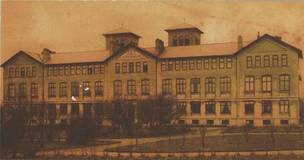
- The Royal Institute for the Deaf-Mute in Fredericia, established in 1881 after proposals from Malling-Hansen. He was appointed deputy director of the institute.
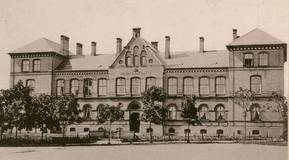
- The Institute for the Deaf-Mute in Nyborg was constructed shortly after RMH’s death after proposal from the commission that he headed until 1889; its establishment represented the completion of his vision of a uniform public supply of education for Denmark’s deaf-mute children, organized and taught in accordance with a coordinated, overall plan.
The general public knows practically nothing about Malling Hansen’s services for the cause of the deaf-mute in Denmark; they are not easily detected to most people, and only a small group of professionals knows how to assess his merits.
But when it is said in a report from the 1889 commission that “all of the institutions for the deaf-mute are united and co-ordinated in a system, within which each and every deaf-mute child is referred to a specific institute, whose teaching is adapted to his physical disability and his mental level, and that such a systematic organization of the deaf-mute is found nowhere else than in Denmark”, then this extraordinary result is due, first and foremost, to Malling Hansen. Already in 1867 the Ministry decided, after proposal from the Institute for the Deaf-Mute and the private (Keller) school for the deaf-mute, that as from that year there must be a differentiation among the children called to be enrolled, i.e. de actually deaf-mute were to be taught at the Institute, while the not fully deaf-mute, and also the mentally retarded deaf-mute, were referred to the Keller institutions.
By this, we gained an important rational foundation for the education, which in the case of the not fully deaf-mute would be based on the speech method, while the sign method would be maintained at the Institute for the Deaf-Mute as its most important teaching method.
However, this step marked only the begining.
In 1879 Malling Hansen presented a proposal for the establishment of an Institute for the Deaf-Mute in Jylland for the category of actual and fully deaf-mute pupils, where they would be taught exclusively according to the speech method, and through his energetic approach the Institute for the Deaf-Mute in Fredericia was established in 1881.
The victorious advance of the speech method in this country has, to a large extent, been supported and driven by Malling Hansen.
Adding to his efforts for the cause of the deaf-mute, it should be noted that in 1868 he visited a large number of the institutes for the deaf-mute abroad. In 1872 he was one of the leaders of the Nordic meeting in Copenhagen for teachers of special education in Scandinavia; and he was a very active and influential member of the commission set up in 1888 which proposed, among other things, that the Government should take over the Keller Institutions and establish a school in Nyborg, leading to the Law of 11th April 1890.
In reality the cause for the deaf-mute was the leitmotif in Malling Hansen’s life, and all other interests that captured his mind were rooted in the deaf-mute; thus, it was also in his work with this group of pupils that led him to grapple with that, which has perhaps mostly made his name re-known far and wide, i.e.
The Writing Ball
Malling Hansen had observed, that while it is possible to write by hand only about 4 phonemes per second, it is possible to pronounce 20 phonemes per second, or a little more than that, in the case of jingles or some other type of very quick speech. On the other hand, he found that in public speeches, the speaker will rarely pronounce more than 15, sometimes only 9 phonemes, and hence the spoken word is from 2 to 4 times as quick as the handwriting.
If one knows little about the finger sign speech of the deaf-mute, one would assume that their communication would be even much slower, but Malling Hansen had observed that a well-trained finger sign speaker – if the expression is permitted – will pronounce or indicate around 12 phonemes per second, i.e. he will “speak” 3 times as fast as we are able to write by hand.
These observations and facts led him to the path of inventing the writing ball.
A similar device like the typewriter had previously been used for blind people, just that such machines would print embossed letters against inked paper, set against ordinary paper behind. It was a very slow process – even for sighted people – since each type had to be picked up separately, put into place, receive the imprint and then put aside again. In contrast, on the writing ball the types were placed onn the lower end of prismatic pistons, in the upper part capped by keys (buttons) with an indication of the letters or signs they would carry below, and kept away from the paper by means of steel springs.
All of these pistons were placed in the direction of the radii of a part of a ball – hence the name – where the paper surface constituted the centre of this ball.
When pressing the pistons, one after the other, all of the letters and signs would be in one single place, unless the paper was moved. The small figure on the illustration of the first writing ball shows the machine seen from the outside, and above we see den actual writing ball with its protruding pistons.
The largest figure – in the same illustration – shows the inside of the machine. The lid, onto which the writing ball is placed, has been opened up, allowing us to see the inner parts of the device. The writing paper together with the inked paper is fastened to a cylinder (middle of the figure), and at the right hand end it carries a projecting disc, at the edge of which has been cut a screw thread, that engages with a rack-and-pinion below. The effect produced is that the cylinder is not only turned around by the ticking clock but is also shifted along its axel, for which purpose it has the sufficient length.
It will then be understood, that one of the types – if it was kept in contact with the paper while the clock was turning – would make a screwed line on the paper, which, when removed from the cylinder, would appear as a row of parallel lines. Now, if the clock had a speed of circulation congruent with the level of skill of the person typing, then the typist would only need to press the different pistons that he needed to use, the corresponding letters would then line up, and an extended stop between two words would then provide a wider space between the words than between the letters in the same word. However, it will easily be realized that only by very long practice would one be able to achieve equally long spaces between the letters. The machine has therefore been designed in such a way that the cylinder will only jump when one of the pistons is pressed down, and this happens by means of electromagnetism. The writing ball therefore consists of two concentric hollow balls, isolated from each other. One of these is connected with a pole of a galvanic device (left side of the illustration), the other one is connected to an electro-magnet (front, right hand side of the illustration) and from there to the other pole of the apparatus. The pistons are all connected to the inner ball but insulated from the outer ball; when one of them is pressed down its key will touch a spring and connect the current. The electro-magnet will attract an armature, positioned just above it, and an escapement, connected to it by means of levers, is released, whereby a gear wheel, positioned at the end on the right hand side of the shaft of the cylinder, is driven forward ½ a tooth, and the letter is pressed against the paper. When letting go of the piston, this will revert, the current is interrupted, the armature is removed from the electro-magnet, the wheel is yet again turned ½ a tooth and remains at rest until the next letter is pressed down. In order to make the necessary spaces between words with this device, on top of the ball is a piston without sign or letter, which when pressed down will move the cylinder a little forward without leaving any mark.
The speed one could obtain with this machine was, of course, first of all dependant on the mechanism, that is: how many movements the electro-magnet would let the armature and the escapement make in a second, but also dependant on the placement of the letters on the ball. Malling Hansen had arranged it in such a way that each finger had, at the most, three pistons to strike. The consonants were typed with the right hand, the vowels with the left, and the letters were ordered in such a way that the most nimble fingers would strike the letters most commonly used. The machine could easily produce 12 signs per second, allowing the typist to keep up with a rather quick speech. In March 1870 Malling Hansen obtained a patent and 15 years of sole and exclusive rights on his speed writing apparatus in its first version, and the general public heard again and again about it; it was written about, illustrated and described in Danish, German and British newspapers and magazines, it was shown at the exposition here in 1872 and in Vienna in 1873 and on both occasions awarded prizes. However, already in 1871 it appeared in a very much modified version – far more practical than the first version.
The paper was no longer rolled around a cylinder, rather it was placed flat on a so called carriage; it was smaller in size and cheaper to produce.
Already during the period of the summer exhibition Malling Hansen and the owner of Professor Jürgensen’s Establishment, master mechanic and professor C.P. Jürgensen, obtained 13 year’s sole and exclusive rights concerning a so called Tachygraph (i.e. speed writer), the writing ball in a new version which would make it possible for a trained typist to type 20 letters per second, about 5 times as fast as writing with a pen and thus allowing the typist to follow even a rather fast speaker. No wonder that it created a stir, the British and the Austrian patents were sold, and there were orders from Russia and from Italy.
Unfortunately, it was not possible to execute the orders, since the inventor was not inclined to produce the machine industrially, and where it did appear, it turned out to be a not negligible difficulty that electro-magnetism was necessary. At the time, people were not so used to deal with electrical components as nowadays, they were neglected or bungled, and then people complained about the writing ball as being impossible. It therefore became necessary to abandon this cumbersome fitment, and in this situation we had evidence of Malling Hansen’s extraordinary mechanical skills: When the mechanics had given up, he himself resolved the task, and this is how he did it: the pressing-down movement, that carries the piston downwards, at the same time puts the entire ball piece, in which the pistons are joined, in a rocking movement, a tiny stay rod is thereby made to tag into a gear wheel, which is moved ahead by one tooth, the movement goes on, and the paper is being moved the width of one letter.
The machine was by now in such a state, that it must be considered perfect for its mission. Malling Hansen was the first person to have produced a really practical, useful speed writing machine.
However, this does not mean that he was the only one to have worked with such challenges.
The very first attempts can be traced back almost 40 years from his period, but initially the motivation was merely to create a means of communication for blind people to communicate in writing, and an apparatus for this purpose had been made already in 1838 by the blind teacher Louis Braille, and in 1851 at the London exhibition there were several similar instruments, as well as in Paris in 1853. However, it is a novel idea that such machines could also be useful for sighted people, and it is surely interesting to note that in our country Malling Hansen was led to this idea in connection with his work as principal of the institute for the deaf-mute.
In the meantime, in America C.L.Sholes, together with two other persons were working with a view to produce speed writing machines for sighted people, and as from 1868 they received patents on their “Type-Writer”, but from the descriptions (Scientific-American of August 10, 1872) it appears that they must have been very different from Malling Hansen’s.
However, in the States there was keen interest in the latest Malling-Hansen model and it was found to be useful and good. One patent agent, at least, attempted to acquire the Malling Hansen patent, and also the businessman who sold the Sholes model, offered the Danish inventor to exchange patents, meaning that they would be entitled to use each other’s patents.
In “illustreret Tidende” of January 16, 1876, C, Nyrup published an article which remains of great interest at present. “From the point of view of the inventor”, it reads, “the issue has by now been brought to a point of development, where the general public will be able to make good use of it, and now it is a public matter to develop it further and actively support the invention, because if this does not happen we might well see a situation rather soon where the Malling Hansen invention will be exported to us as a foreign product. In New York there have already been invitations to form a consortium aiming at the fabrication of the writing ball.
Unfortunately the prophecy was fulfilled. Lacking financial funds Malling Hansen could not compete with the big American companies; his name is not linked to any typewriter presently in use, alas, we might almost say that his name has been forgotten.
Xerography
While working with the writing ball, Malling Hansen also grappled with the problem of be able to make copies of the typed pages, and this led to a method, that even without the writing ball would produce a considerable number of copies.
The previously known methods, by which a smaller number of prints could be produced, were limited to these two: On top of a piece of paper where text had been written by hand, using copying ink, was put a sheet of moisturized and transparent paper, and the two pieces were then pressed together in a copying press, thus obtaining an imprint of the text on the underside of the transparent sheet. Hence, there are now two identical specimens (duplicate), and by once again making an imprint of the original on transparent paper, you will have a third copy (triplicate), however normally the last one will turn out very faint.
By the second method, used at telegraph stations, a piece of paper was placed on a hard surface and on top of that a piece of inked paper with the inked side facing downwards; on the inked paper was put writing paper etc in 4-6 double layers. Using a hard pencil or agate point and pressing hard one would write on and through all of these layers, and hence would obtain as many copies as there were layers – normally no more than six, if ordinary writing paper was being used, and about 12 if tissue paper was used.
The new method had, in its first step, some similarity with the second method. Malling Hansen used blue ink paper and writing or typing through the layers, but instead of placing the writing paper at the bottom and on top of that putting the inked paper with the inked side downwards, he would place the inked paper at the bottom, inked side facing upwards, and on top of that a sheet of oiled paper, then inked paper with the inked side upwards, oiled paper, inked paper etc, for instance in five layers.
These layers were now written or typed upon, and in this way he would have 5 identical specimens, on which the writing or the drawing was reverse on the side, that during the writing was facing downwards. From each of these five specimens he was then able to produce no less than 20 copies, and hence would get 100 prints in addition to the five originals, and this would be done as follows: Between the five originals he would place writing paper, and this heap would then – under rather light pressure - be run through the two rollers of a small glazing machine. The writing would then be printed on the five sheets of writing paper. Once again paper was placed between the already once used originals, and they were again run through the rollers, but this time under slight stronger pressure, and one would then have 10 specimen. This copying process could – under increasing pressure from the rollers – be repeated no less than 20 times, and all the 100 copies would be produced in 6 to 7 minutes, all of them clear and sharp, even the writing on the five originals would be perfectly clean and easily read, in spite of the fact that from the original mould, making the imprints from the start, ink had been released to no less than 20 copies. By writing through twenty originals in one go, one would get, in 10 minutes, 200 identical specimens. The novel idea in this method is based on the fortuitous discovery made by Malling Hansen: that the writing on the blue ink paper under certain conditions can be made to produce copies so many times without losing its intensity and clarity. The colour from brown, black or any other kind of inked paper can produce merely a couple of useful copies, whereas the blue paper, provided it is the kind of deep, intensive colour that we call Berlin blue[1] is able to produce a surprising number of imprints.
Of the pre-conditions indicated, the following are the most important: The inked paper must be thin and the ink must be finely ground, the oiled paper must equally be thin, hard and very dry; this – in combination with being saturated with oil – enables it to absorb the colour from the inked paper without keeping it and is immediately able to release it again. The paper on which the imprints are made must be of even quality – not grooved or striped, but yet also not very smooth or sleak.
One would write with an ivory pin or, in case one needed 20 identical copies, and had only one original, then one could write with an ordinary pen and ink.
This new method was called “Xerography”(i.e. “dry printing”) and was, at the time, the quickest method to produce many copies. That also this invention attracted attention is evidenced by the following press statement:
“We would be very pleased if our compatriot, who has already made his name known and respected abroad through the writing ball, with this new method will consolidate, even stronger, the advantageous reputation by which his invention has hitherto been accompanied everywhere, and rightfully, deservedly so.”
Was Malling Hansen the Inventor of the Writing Ball?
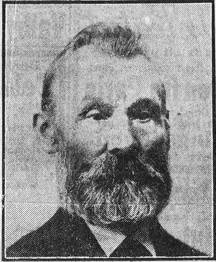
- An old photo from “Berlingske Tidende” of the Danish teacher and counsellor J.A. Peters, 1835-1924, who also constructed a typewriter.
The captioned question may seem odd, considering the information previously given and, indeed, before 1921 this question would have been unthinkable. However, in “Berlingske Tidende” of November 12 that year[2], professor H.I. Hannover published an article claiming that the recently diseased counsellor, previously teacher in Flensburg, J.A. Peters, was the real inventor of the writing ball.
The assertion probably came as a surprise to everyone – not the least to the still living daughters of Malling Hansen. This sparked off a controversy between them and the professor – at times with very harsh and sharp words exchanged between them. It would take us too far in this article to describe the details of the discussion, but the issue is of considerable importance and shall be briefly mentioned here[3].
The professor had reached his conclusion following the acquisition by the “Historical Technological Collection”[4] of an upper part of a device “reminding of a writing ball”, constructed by counsellor Peters. Hannover had also had a conversation with Peters, leading him to the conclusion that Peters had invented the writing ball several years before Malling Hansen’s machine, and his impression was confirmed by Peters.
Peter’s machine is described in “Illustrirte Zeitung” October 12, 1872, as invented in 1868; but the machine from 1868 is described that same year in “Berlingske Tidende”, and the two descriptions are not at all in harmony. In “Berlingske Tidende” it is described as “having the shape of a middle-sized round table and having an outside appearance of the so called square pianoforte”. In contrast, the picture in “Illustrirte Zeitung” shows an object similar to the so called “cache-pot”, a much smaller but probably much more practical model, that has only the principle of the lever in common with the model from 1868, but otherwise it is a totally new construction from 1871. Peters has –and this is why he was being perceived at the first one – in relation to “Illustrirte Zeitung” failed to disclose that the presented model was new. The editors have then assumed it was the model from 1868.
In addition, it should be noted that Peters did not get patency rights on any machine in 1868, he did not obtain the patency right until the beginning of 1872.
The article in Ill. Zeitung is, hence, not correct at all, nothing can be based on it, and the above, initial question must be answered – before as well as after 1924 – with an unconditional ‘yes’.
In the course of the controversy about these issues professor Hannover, incidentally, commented rather disparagingly about the writing by Malling Hansen’s writing ball, declaring that the letters were smudged. However, from the adjacent typing samples the reader may make his own judgement. – By the way, Ms Engelke Wiberg, née Malling Hansen, approached the president of the association of typewriter importers in Denmark in order to have an expert opinion and received the following reply:
The Society has the honour to state[5], “that their (the printing samples) quality in our judgment is excellent and fully at the level of modern typewriters at present in terms of beautiful and clear print”. In other words, Malling Hansen’s writing ball could, also in this respect, compete very well with our present day current brands.
Biological Studies
Also as a biologist Malling Hansen achieved the highest levels. His scientific work:“Periods in the Growth of Children and in Solar Heat”, became well-known all over Europe and has its origin in a practical and rather down-to-earth investigation of the optimal dietary regulations at the Institute for the Deaf-Mute. This investigation led him on to carry out various kinds of weight checks of the children, and we will get a good impression of how meticulously he proceeded by reading this paragraph in the above quoted work: “The pupils are weighed four times per day all year round, except in the period from mid July until the end of August, when the children have left the Institute for summer vacations. The last weighing of the boys takes place every evening at 9 o’clock, except in June-July when it is done at 9 ½. Previously the boys were divided into eight permanent groups, now only in four, each consisting of 16-18 children. “ Weighing each group took around 15 seconds, and for the first 8 months was done by Malling Hansen himself, thereafter the evening weighings were distributed between five of the teachers of the Institute. These were continued for approximately 4 years, and on the basis of these weight checks a common rule for the development of the weight of a child throughout a year would be formulated as follows:
The weight of a boy in the age group nine to fifteen years old will each year pass through three main periods, a maximum, a medium and a minimum period of growth development. The maximum period starts in August and ends in mid December, i.e. will last for 4½ months. The medium period is from mid December until the end of April, 4½ months. The minimum period is from the end of April until the end of July, 3 months. In the maximum period the daily weight increase is nearly 3 times as much as in the medium period. Almost the entire weight gain during the medium period is lost in the minimum period.
Also the height of the children was the object of observation, as they were measured once a day, and the result of these measurements were as follows:A nine to fifteen year old boy’s growth in terms of height will each year pass through 3 main periods, a minimum, a medium and a maximum period. The minimum period starts in August and continues until the end of November, ca. 3½ months. The medium period is from the end of November until the end of March, i.e. around 4 months. The maximum period stretches from the end of March until mid August and covers about 4 ½ months. The daily growth in height during the medium period is twice the growth measured in the minimum period, and in the maximum period it is 2½ times as much.
The said periods of growth in weight and height are not influenced by the diet or activity of the children.
From the children Malling Hansen now turned to the trees in the Institute garden, and after numerous measurements found that the relationship between the growth in length and thickness of the trees showed essential similarities with the same growth periods in the case of the children. The maximum period of the growth in length was followed by the maximum period in terms of growth in thickness; and during the growth in length essentially there is a resting time for the growth in thickness, and vice versa.
His studies became important not only for physiology but also for meteorology and astronomy. Through a series of penetrating and brilliant investigations he found that the upper mentioned periods in the growth of the weight and height of children were due to cosmic influence, indeed, that all organic functions on planet earth are in constant congruent intensity fluctuations, for which the impulses emanate from the sun, arriving in or with the solar heat waves.
By means of these investigations he achieved the most coveted recognition possible. At a medical congress in Copenhagen he – the pastor and teacher of the deaf-mute children – gave a presentation about periods in the growth of children, and all the most outstanding representatives of the medical science cheered him with thundering applause. After his demise he was also hailed, in the foreign media, as one of the leading biological researchers.
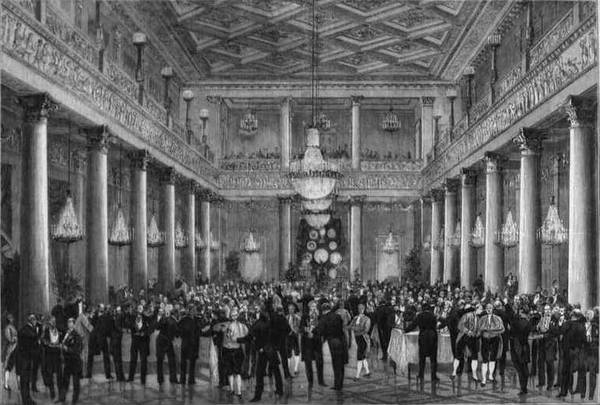
- On the last day of the medical congress in 1884, the Danish King organized a gala night at Kristiansborg Castle. It is fair to assume that Malling-Hansen was present among these elegant gentlemen. Photo: The Royal Library. JMC: incidentally, the medical congress took place August 10-16, and only shortly afterwards, Kristiansborg castle was destroyed – October 3, 1884 - in a devastating fire. Many valuable documents were lost – among them documents pertaining to Rasmus Malling-Hansen and his work.
The above description, and generally whenever we study Malling Hansen’s life and activities, leaves us with the impression of a man with a keen power of observation in all areas, a quiet observer who did not see any effects without researching for the causes, pondering his observations by a quiet, internal process of analysis, until the stage where they had obtained solid form. Then with extraordinary zeal he would launch himself into a study of the details needed to further clarify, inform and prove his ideas; he would collect facts by the hundreds from the most diverse quarters, pursue his goals year in and year out with tireless fervour, and then he would start, slowly and little by little, to erect the building from the ground, already having a vision of its dome soaring high above.
Nature had granted him rare gifts: some of the intuitive power, which is genius, an ability to make himself acquainted, with effortless ease, with the various branches of science; a composed disposition and serenity as well as a particular flair for finding clues and connections.
In spite of his many disappointments, Malling Hansen was definitely an optimist. While very introvert, he could also be lively and cheerful; he was extraordinarily musically gifted and was very much admired for his ability to play the organ.
He would be happy to see other people’s joy and could be exceedingly helpful. He was, for instance, a great support to Mr.Voigt[6], the engineer, who for many years grappled with plans for a steerable balloon, and he helped him with, among other things, some mathematical calculations and constructions.
Likewise, it was at his suggestion and impulse that Ludvig Feilberg[7], long time ago, published his philosophical works. Malling Hansen perceived clearly that Feilberg’s independent thinking and ideas were very meaningful and important.
As a curiosity I would also like to mention that Malling Hansen was the first one to present the theory that the reason for the extraordinarily pretty and colourful sunsets, appearing in 1883-84, must be linked to the violent rain of ashes ejected from the eruption of the volcano Krakatau.[8] He thought that the refraction of the sunrays in the ash cloud in the atmosphere were producing the gorgeous colours of the sunsets, - a theory subsequently accepted and confirmed by scientists.
In a small society like ours the pre-conditions are not propitious for “heroes” emerging, - albeit the reasons are probably to be found in other aspects and deeper layers than merely the small size of our country. It has rightfully been said about our great men in the realms of politics, arts and the intellect, that they have almost never been able to achieve the highest level of greatness, they are “close by”, “on the verge of”, but never more than that.
Malling Hansen is no exception from that rule. He reaped no other fruits than disappointment from his typewriter, and he did not succeed gaining acceptance and demand for it in wider circles, neither in his own country nor abroad. He paid the foundation for a new scientific method and indicated roads which his successors could follow, but he himself only travelled a short distance of these roads.
‘A pioneer of science’ is the honourable epithet due Malling Hansen, but this by no means exhausts his personality, for he was much more than that. We must also keep in mind that he was a father for the poor children, confided into his care, a true humanitarian and a truly good man.
Data
Born September 5, 1835. Graduation from Jonstrup College in 1854. Assistant teacher in Maglemer by Saxkjøbing[9] for 1 year as from July 1, 1854. From January 10, 1859 teacher at the Royal Institute for the Deaf-Mute in Copenhagen. From October 1, 1861 at Regensen. October 1, 1862 teacher at the Royal Institute for the Deaf-Mute in Schleswig Town, as from April 23 1863 and until February 1864 principal at the same institute. Bachelor of Divinity June 27, 1865. That same year principal and first teacher at the Royal Institute for the Deaf-Mute in Copenhagen and as from September 1 the same year also pastor at the institute. May 31, 1872 the Medal of Meritorious Services in gold. Awarded the Austrian gold medal ”pro litteris er artibus” in 1873 for his invention of the writing ball. June 26, 1876, Knight of the Swedish Order of the Wasa. Gold medal at the 1878 Paris exhibition and on February 2, 1880, Knight of the Dannebrog. 1882 Assistant Director of the Royal Institute for the Deaf-Mute in Fredericia. Died September 27, 1890.
Married: Married first time with Cathrine Georgia Heiberg, daughter of professor Søren Heiberg, pastor and principal of the Royal Institute for the Deaf-Mute (the predecessor of Malling-Hansen. In this marriage there were 7 children, but the mother died in 1876. Married second time with Anna Cathrine Maria Steenstrup, daugther of judge in Frederikshavn Michael Vogelius Steenstrup, dead 1897.
Unfortunately we have very scant information about the author of this article, Arild S. Ebbe. We know that he was a teacher by profession and he was the author, together with N.C.Arndal, of a textbook in physics for the elementary school level, published in four parts in 1929-31.
Malling-Hansen’s daughter, Johanne Agerskov, left behind a letter from Ebbe, dated 27/6 – 1928 with the following words:
Ms Johanne Agerskov, born Malling-Hansen.
With many thanks for the loan I return the attached; I hope and trust that all that which I borrowed has been safely returned, except, of course, your book ”Who is the inventor of the Writing Ball?” that you were so kind to offer to me. I also take the opportunity to thank you for all your assistance during my work with the article in the Jonstrup book, of which I attach a copy. The book is a year-book for old alumni of Jonstrup.
Sincerely, your devoted Arild S. Ebbe.
[1] JMC: Other names for the same colour are: Prussian blue, Parisian, or Paris blue. It is a synthetic colour, produced in Germany (Prussia) as from 1706 and since then widely used in oil paintings, watercolour and for dyeing. Japanese painters and woodblock print artists did not have access to a long-lasting blue pigment until they began to import Prussian blue from Europe in the 18th century. Interestingly enough, this syntethic colour is edible in small doses and is even being used as medicine, - as an antidote in case of certain kinds of heavy metal poisoning, e.g. thallium and radioactive isotopes of caesium (source: Wikipedia).
[2] JMC: The author is mistaken about the dates and year; the first Hannover article, starting the controversy, was published in Berlingske Tidende March 12, 1924. See also the documentation about the writing ball controversy 1924-25 on our site.
[3] ASE: Readers who wish to study the issue in detail are referred to Ms Johanne Agerskov, née Malling Hansen’s publication “Who is the Inventor of the Writing Ball?”
[4] JMC: This important collection was later on transferred to the Danish Museum of Science and Technology, founded in Copenhagen in 1911 and in 1966 moved to Elsinore. The museum owns a piece of the Peters machine; it also has nine different Malling-Hansen writing balls.
[5] ASE: The written reply is dated 20th December 1924 and is signed F.C. Larsen, President.
[6] JMC: This is a very interesting piece of information: that RMH, without scientific training or education, was able to render assistance to an engineer in these areas! The friend in question is probably Julius Jensenius Voigt, 1850-1922, a Danish engineer.
[7] JMC: Ludvig Tage Christian Müller Feilberg, 1849-1912, Danish engineer, psychologist and philosopher.
[8] Krakatau is a volcano located in the strait between Sumatra and java. Krakatau erupted August 26 and 27, 1883, and this is recorded as one of the most violent and devastating eruptions in human history. The ash cloud generated was spread all over the earth at the altitude of 80 kms. Because the ash cloud was so thick, it reflected the sunlight and had the effect of lowering the global average temperature by about 1,2 degrees celsius during the following years. Besides, the ash cloud produced vivid and dramatic colours of the sky, and it has been suggested that the sky colours of the famous painting “the Scream” by Edvard Munch are completely natural, just as he observed them. The blast wave was measured on barometers all over the world and went around the planet seven times before stopping. Krakatau remains active today with eruptions in 2009, 2010, 2011 and 2012.
[9] JMC: This must be a mistake; Maglemer is situated close to Hunseby and close to Maribo.
Malling-Hansen Biografi af Arild S. Ebbe
Transkribering, kommentarer og illustrasjoner ved Sverre Avnskog.
Denne biografien av Arild S. Ebbe ble trykt i Jonstrup-boken fra 1928. Dessverre har vi ikke særlig mange personlige data om Arild Ebbe, men han er nevnt i "Jonstrupsamfundets medlemmer", og der står følgende: "Ebbe, A.S., Dimissionsaar: 1910, Stilling: L (dvs lærer) og adresse: Prinsesse Maries Allé 7, København K." Sikkert er det i hvert fall, at Ebbe satt inne med en meget grundig kjennskap til Rasmus Malling-Hansens liv, og han gjengir blant annet en tale som Malling-Hansen holdt kort før sin død, ved 100 års jubileet for Junstrup Statsseminariums opprettelse - 4. august 1890. Arild S. Ebbe skriver Malling-Hansens navn uten bindestrek, slik han selv skrev det inntil ca 1882-83, da han begynte å skrive navnet sitt med bindestrek, Malling-Hansen. Opprinnelig var "Malling" en del av hans fornavn, da han var oppkalt etter sin forsterfar, Rasmus Malling, og ble døpt, Hans Rasmus Malling Johan Hansen.
Malling Hansen
Af Arild S. Ebbe
”Det lille Lands smaa Forhold og Skepsis, den indskrænkede Plads herhjemme, Følelsen af at sidde inde i en lille Vig, medens de store Bølger gaar udenfor, tyngede denne Mand.
Som saa mange andre begyndte han med frejdig Mod og saa i sin Livlige Fantasi alle Hindringer ryddet af Vejen, men Tiden gikk og lærte ham det samme som Skytten Bryde om Ærens Tornevej. Han saa i Tankerne Statuen rejst, men naaede kun at frembringe en Torso.” Saadan skrev Illustreret Tidende ved Malling Hansens Død i 1890.
Den havde sikkert Ret, og dog naaede Malling Hansen meget. Han opfandt Skrivekuglen, Takygrafen, og Xerografien, stod som en meget fremragende Biolog og døde – kun 55 Aar gammel – som Forstander og Præst ved Døvstummeinstitutet i København.
Det manglede vel saaledes ikke Solskin paa hans Vej, og det kan heller ikke siges, at han stødte paa haardnakket Modstand, men han mødte ofte Ligegyldighed, hvor han havde ventet at finde Varme, Tilbageholdenhed, hvor han havde haabet fuld Tilslutning. Man troede ikke helt paa ham, hørte ham kun halvt og vilde kun vove lidt.
Hans Rasmus Johan Malling Hansen – der skrev sig R. Malling Hansen – blev født den 5te September 1835 i Hunseby paa Lolland. Faderen, Joh. Fr. Hansen, var Lærer i Havlykke, Moderen var Juliane Cathrine, f. Matzen.
Efter Faderens tidlige Død (1839) kom han i Huset hos den mærkelig dannede og dygtige Skolelærer Rasmus Malling i Hunseby. (Rasmus Malling blev dimitteret fra Jonstrup 1808 og samme Aar Lærer i Hunseby. R. C. M.) Hos denne sin Plejefader – efter hvem han antog Navnet Malling – mødte han de første Indtryk fra den store Verden udenfor, og Lysten til at blive noget stort vaagnede i ham. Den opvakte og livlige Dreng, der havde adskillige Talenter, blev imidlertid, da han havde naaet en passende Alder, sat i Malerlære i Maribo, da der ikke var Raad til at holde ham til Bogen, og han maatte saaledes foreløbig sige sine ungdommelige Drømme Farvel.
Da viste der sig imidlertid en deus ex machina – Grev Knuth til Knuthenborg – der havde hørt den flinke Skolelærersøn omtale, og ved hans Hjælp kom han paa Jonstrup Seminarium, hvor han efter et 3-aarigt Ophold tog Eksamen i 1854 med Karakteren: Udmærket duelig.
Jonstruptiden.
Sit Ophold paa Jonstrup omtalte han altid med den største Kærlighed og Taknemmelighed. Følelser han saare smukt fandt Udtryk for i sin Tale ved Jubilæumsfesten for Seminariets 100-årige Bestaaen den 4. august 1890.
Egentlig blev den officielle Fest afholdt den 25. Juni – 100-Aars Dagen for Udstedelsen af det kongelige Reskript – men visse Forhold, og deriblandt det, at det store nordiske Skolemøde det Aar blev holdt i København først i August, førte til, at 43 tidligere Elever med Malling Hansen – da forstander ved det kgl. Døvstummeinstitut – som Formand, innbød til en Fest den 4. August.
Indbydelsen blev efterfulgt af ca. 200 forhenværende Elever, og efter at Lærer Betz, Idestrup paa Falster, havde talt for Kongen, fik Malling Hansen Ordet for at tale for ”Gamle Jonstrup, samtlige Festdeltagere og i Særdeleshed for Jer Brødre, Sønner af det gamle Jonstrup,” og han udtalte tilsidst omtrent følgende:
---
”Og ser jeg da paa min Jonstrup-Tid, der ligger omtrent 40 Aar tilbage, for at finde det, hvorom vi all vil kunne samles i fælles Tak til Jonstrup, - saa træffer jeg allerførst paa dette: Vi lærte at arbejde, vi lærte at tage fat, vi lærte Flid, et velordnet Arbejde, og ikke at skyde Arbejdet tilside, selv om det ikke behagede os. Der var en Arbejdsomhedends Aand over Seminariet, den udgik fra Seminariets Forstander, fandtes hos næsten alle Lærerne, og gjennomtrængte alle Eleverne saaledes, at den, der var uhelbredelig Driver, tillige var nær ved at blive til Nar for de andre. Naa, det udelukkede jo ikke, at vi som glade, ægte Unge, ikke var bange for at tage os en Ræv eller at komme på Støvlerne engang imellem; men Flid var der indenfor den gamle Borg, og Flid lærtes der, og Flid og Arbejdsomhed har Jonstrups Sønner bragt med ud i Danmark gennem alle Tider. Og derfor: Tak, gamle Jonstrup!
Det Næste, hvorom vi Alle kan samles i Tak, det er vor pædagogiske Uddannelse, den, der nu kimses saa meget af. Fik vi end ikke meget Øvelse i pædagogisk Gerning, saa fik vi et sundt Grundlag af Kundskab og Forbilleder, der vel ikke i Reglen kunde føre til Glimren ved en Embedsprøve, men som var et sundt og godt Grundlag, vi selv kunne bygge videre paa i Livet, i Lærer-Gerningen. Hva Værd et saadant Grundlag har, og hva det vil sige at mangle det, ja det har jeg i mit Liv saare ofte erfaret, naar jeg stod ligeoverfor Folk, der uden dette pædagogiske Grundlag begyndte paa en Lærergerning. Jeg har hos saadanne Folk saare ofte igennem lange tider iagttaget en saadan Famlen og Usikkerhed, saa vældige pædagogiske Bommerter, en saa lang Tids Slid, før Arbejdet klarede sig, at jeg mangfoldige Gange i mit lange Lærerliv har haft rig Grund til at takke for min Pædagogiske Uddannelse. Og herom kan vi vist alle samles i et: Tak, gamle Jonstrup!
Og saa, Brødre: Det var i vor fagre Ungdomsvaar, vi var samlede her. Trods Arbejde og Besvær var de dog de gladeste og lykkeligste Aar i vort Liv: Gamle Jonstrup var paa dette Omraade kun i det Ydre en streng Moder, hun saa altid gennem Fingre med mangen herlig Ungdomsstreg og glædede sig til mange Venskaber, der her blev sluttede for hele Livet, Venskaber, som vil staa fast til det Sidste. At vi Alle har Sind til at pleje de glade Minder, selv om Afstand og Aar har splitet os fra hinanden, - derfor Tak, gamle Jonstrup!
Og ser vi nu paa Seminariets Undervisningsvirksomhed gennem de 100 år, saa maa vi takke Jonstrup, fordi det i væsentlig Grad har Æren af, at Lærerstanden, som i Slutningen af forrige og i Begyndelsen af dette Aarhundrede var bagefter sin Tid, nu længe har været forut for den. Det var ikke Lærerstanden, der skabte Seminariet eller anviste og gav Regler for Skolesagen. Lærerstanden fulgte kun efter i de gamle Spor. Men i de sidste 20 Aar er det Lærerstanden, der fører an og peger med Kraft og Inderlighed hen paa, at en videre Uddannelse bør vi Lærere have, men fremfor Alt mer Tid, Undervisningstid for Landsbyskolens Børn, der sandelig ikke er ”overbyrdede”. Lærerstanden ser nu og peger med Kraft hen paa det Fænomen, at mens Jernbane og Telegraf har bragt alle Menensker nærmere sammen, klistret dem op ad hverandre, gjort Jorden lille, har man gjort det at vinde en Position i Livet vanskeligere, Kampen for Tilværelsen vanskeligere, og derved nødvendiggjort, at den Uddannelse, og de Vaaben, Aandens og Hjertets Vaaben, som Skolen giver for Livet, bliver talrigere og skarpere – saa er dog Skoleuddannelsens Fremskridt langt tilbage for de Fordringer, som Nutidslivet stiller til den Enkelte. Gamle Jonstrup har været med til at vække sine Sønners Øjne herfor, og derfor: Tak!
Og ser vi paa den danske Lærerstand igennem de 100 Aar, saa finder vi langt tilbage i Tiden en meget lidet anset Lærerstand, men nutildags finder vi en Lærerstand, som værdsættes omtrent efter Fortjeneste. Lad mig udtale, at dette vistnok som Regel kan siges: Et Land bør værdsættes, efter som det værdsætter sin lærerstand. I denne Henseende er der sket et vældigt Fremskridt gennem Aarene, dertil har gamle Jonstrup ogsaa givet sin Skærv. Derfor: Tak!
En Moder bliver ung i sine Børn! – Nu er det vel saadan, at gamle Jonstrup ikke er ældet, me, trods Aarene, tænker kraftfuldt og ungt, og dette er jo, som det bør være. Det enkelte Menneske ældes, men en Institustion skal ikke kunne ældes, tvertimod: Den skal gennem Aarene blive yngre og yngre, det er: kraftigere og kraftigere. Og dette kan vistnok ogsaa siges om Borgen her. Er dette et skønt Vidnesbyrd, saa maa det siges, at ikke mindre skønt vilde det være, om der endelig engang du fra Landets Lærere kunde gennem Landets Lovgivning gydes ny Kraft ind i Fostermoderen. Det ske!
Hjertens Tak og til Lykke og Fremgang! Længe leve Jonstrup kongelige Skolelærerseminarium!” Kraftige Hurraraab.)
---
Malling Hansens Ord vandt Genklang hos alle de Tilstedeværende, og han takkedes med et ”Leve den berømte Jonstruper”. Ingen anede da, at det skulde blive hans ”Svanesang”. Han døde knapt to Maaneder efter, den 27. September.
Efter endt Eksamen paa Jonstrup var Malling Hansen en kort Tid Hjælpelærer paa Laaland, men blev (atter ved Grev Knuths Hjælp) – sat i Stand til at studere. 1858 blev han Student, og i Begyndelsen af 1859 Lærer ved det kongelige Døvstummeinstitut i København, hvor han fandt en Virksomhed, der interesserede ham. Han opgav dog denne Stilling for at kunne læse til theologisk Embedseksamen, men Studierne blev hurtig afbrudte. Man ønskede nemlig en dansk Mand ansat ved Døvstummeinstitutet i Slesvig, og i 1862 blev Malling Hansen da lærer ved dette Institut og i Begyndelsen af 1864 Forstander for det. Men Krigsbegivenhederne trængte ham væk. Han vendte tilbage til København og tog i 1865 theologisk Eksamen efter kort i Forvejen at være bleven konstituered som Forstander ved Københavns Døvstummeinstitut: endelig Udnævnelse som Forstander og Præst ved det fik han i September samme Aar.
Døvstummesagen.
Den store Offentlighed ved saa godt som intet om Malling Hansens Fortjenester af Døvstummesagen i Danmark, de ligger ikke aabne for alles Blikke og kun en snæver Kreds af Fagmænd forstaar at vurdere dem.
Men naar det i en Kommissionsbetænkning af 1889 hedder, at ”alle Landets Døvstummeanstalter er indordnet som Led i et System, indenfor hvilket enhver døvstum henvises til en søregen Anstalt, hvis Undervisning er afpasset efter Graden af hans legemlige Fejl og hans aandelige Standpunkt, og at en saadan systematisk Ordning af Døvstummeundervisningen endnu ikke findes andre Steder end i Danmark”, skyldtes dette fortrinlige Resultat i første Række Malling Hansen. Allerede i 1867 resolverede Ministeriet efter Indstilling fra Døvstummeinstitutet og den private (Kellerske) Døvstummeskole, at fra nævnte Aar skulde der ske en Sondring mellem de til Undervisning indkaldte Børn saaledes, at de egentlig døvstumme skulde oplæres paa Institutet, medens de uegentlig og aandsløve døvstumme henvistes til de Kellerske Anstalter.
Hermed var der vundet et viktig rationelt Grundlag for Undervisningen, der for de uegentlig døvstummes Vedkommende nu helt grundlagdes paa Talemetoden, medens Tegnmetoden bibeholdtes paa Døvstummeinstitutet som dettes væsentlige Undervisningsmaade.
Dette Skridt var imidlertid kun en Begyndelse.
I 1879 fremkom der fra Malling Hansens Haand et Forslag om Oprettelsen af et Døvstummeinstitut i Jylland for egentlig døvstumme, hvor Undervisningen udelukkende skulde ske efter Talemetoden og ved hans energiske Optræden kom Døvstummeinstitutet i Fredericia i Stand i 1881.
Talemetodens sejrrige Fremtrængen her i Landet er i væsentlig Grad bleven støttet og baaret af Malling Hansen.
Til Oplysning om hans Døvstummevirksomhed kan endnu meddeles, at han i 1868 besøgte en stor Del af Udlandets Døvstummeinstituter, at han i 1872 var en af Lederne ved et Møde i København af de nordiske Abnormeskolers Lærere, og at han var et virksomt og indflydelsesrigt Medlem af en i 1888 nedsat Kommission, der blant andet foreslog, at Staten skulde overtage de Kellerske Anstalter og oprette en Døvstummeskole i Nyborg, hvilket førte til Loven af 11. April 1890.
I Virkeligheden var Døvstummesagen den røde Traad i Malling Hansens Liv, alle andre Interesser, hvoraf han blev greben, havde deres Rod hos de døvstumme; det var saaledes ogsaa i sit Arbejde for disse, at han kom til at tumle med det, der maaske har ført hans Navn videst om, nemlig
Skrivekuglen.
Malling Hansen havde iagttaget, at medens man kun kan skrive omtrent 4 Lydtegn i Sekundet, kan man i Ramser eller i meget rapmundet Tale udtale 20 Lyd eller noget derover i hvert Sekund, hvorimod man ved offentlige Foredrag sjældent udtaler mer end 15, undertiden kun 9, saa at Talen er fra 2 til 4 Gange saa hurtig som Skriften.
Kender man lidt til de døvstummes Fingersprog, skulde man tro, at dette maatte gaa endnu meget langsommere, men Malling Hansen har ved sine Iagttagelser fundet, at en øvet Fingertaler - om man kan sige det – udtaler eller angiver omtrent 12 Lydtegn i Sekundet, altsaa ”taler” 3 Ganger saa hurtig som man skriver.
Denne Omstændighed ledte ham til Opfindelsen af Skrivemaskinen.
En lignende Indretning som Skrivemaskinen havde man før anvendt for blinde, kun at disse trykkede ophøjede Bogstaver mod affarvende Papir med almindeligt Papir bag. Det gikk meget langsomt – selv for seende – da hver Type skulde frem, stilles paa Plads, modtage Trykket og atter lægges til Side. Paa Skrivekuglen var derimod Typerne udskaarne paa de nederste ender af prismatiske Staalstilke, som foroven endte i Knapper, forsynet med de Bogstaver, de bar forneden, og holdt borte fra Papiret med Staalfjedre.
Alle disse stilke laa i retningerne af Radierne til en Del af en Kugle – deraf Navnet – igennem hvis Centrum Papirfladen gikk.
Naar man nu trykkede alle Stilkerne ned, den ene efter den anden, vilde alle Bogstaverne komme til at staa paa eet Sted, hvis ikke Papiret blev flyttet imidlertid. Den midste Figur paa Billedet af den første Skrivekugle viser Maskinen udefra, og man ser foroven den egentlige Skrivekugle med sine fremstaaende Stempler.
Den største Figur – paa samme Billede – viser Maskinen indvendig. Laaget, hvorpaa Skrivekuglen er anbragt, er lukket op, saa man kan se Apparatet indvendig. Skrivepapiret sammen med det affarvende Papir er klemt fast paa en Cylinder (midt i figuren), men paa Enden til højre bærer den en fremspringende Skive, i hvis Rand der er indskaaret en Skruegang, som griber ind i en Tandstang forneden. Derved bevirkes det, at Cylinderen under Urets Gang ikke blot drejes rundt, men tillige forskydes langs ad sin Akse, hvortil den er tilstrækkelig lang.
Man vil da indse, at en af Typerne – hvis den blev holdt i Berøring med Papiret under Uters Gang – vilde tegne en Skruelinje paa det, der, naar det toges af Cylinderen, vilde vise sig som en Række af parallele linjer. Hvis nu Urets Gang havde en Hurtighed, der stemmede med Øvelsen hos den skrivende, behøvede denne blot efterhaanden at trykke paa de forskellige Stempler, han skulde bruge, de tilsvarende Bogstaver vilde da stille sig i Række, og et forlænget Ophold mellem to Ord vilde da give en større Plads imellem Ordene end mellem Bogstaverne i samme Ord. Det ses imidlertid let, at man kun ved meget stor Øvelse vil kunde opnaa at faa lige store Afstande imellem Bogstaverne. Maskinen har derfor faaet en saadan Indretning, at Cylinderen kun gør et Spring, naar et af Stemplerne trykkes ned, og dette sker ved Elektromagnetisme. Skrivekuglen bestaar derfor af to koncentriske Kugleskaller, som er isolerede fra hinanden. Den ene af disse er i Forbindelse med den ene Pol af et galvanisk Apparat (til venstre paa Figuren), den anden staar i Forbindelse med en Elektromagnet (forrest til højre i Figuren) og derfra med den anden Pol af Apparatet. Stemplerne er alle i Forbindelse med den inderste Kugleskal, men isolerede fra fra den ytre; naar et af dem trykkes ned, kommer dets Knap i Berøring med en Fjeder og derved sluttes Strømmen. Elektromagneten tiltrækker et Jernanker, som er anbragt lige over den, og et Hemværk, som ved Vægtstænger er sat i Forbindelse med dette, udløses, hvorved et Tandhjul, der er anbragt paa Enden til højre af Cylinderens Saalakse, drives ½ Tand frem, Bogstavet trykkes mod Papiret. Slipper man Stemplet, gaar dette tilbage, Strømmen afbrydes, Ankeret fjernes fra Elektromagneten, Hjulet drejes atter ½ Tand og bliver i Ro, til næste Tegn Anslaas. For med denne Indretning at kunne gøre de tilbørlige Mellemrum mellom Ordene, er der øverst paa Kuglen anbragt et Stempel uden Type, som ved at nedslaas bringer Cylinderen et Stykke frem uden at sætte noget Mærke.
Den Hurtighed man kunde opnaa med denne Maskine afhang selvfølgelig for det første af Mekanismen, nemlig af, hvor mange Bevægelser, Elektromagneten kunde lade Ankeret og Hemværket gøre i et Sekund, men ogsaa af Bogstavernes Ordning paa Kuglen. Malling Hansen havde ordnet dem saaledes, at hver Finger i det højeste havde tre Stempler at anslaa. Konsonanterne ansloges med højre, Vokalerne med venstre Haand, og Bogstaverne var saaledes ordnede, at de mest bevægelige Fingre anslog de hyppigst forekommende Bogstaver. Maskinen kunde let frembringe tolv Tegn i Sekundet, saa man kunde altsaa med den følge en nogenlunde hurtig Tale. I Marts 1870 fik Malling Hansen 15 Aars Eneret paa sin Hurtigskrivningsapparat i dets første Skikkelse, og Publikum hørte atter og atter om det, det blev omtalt og afbildet og beskrevet i danske, tyske og engelske Blade, det fandtes paa Udstillingen her i 1872 og i Wien i 1873, og begge Steder blev det prisbelønnet. Allerede 1871 optraadte det dog i en meget forandret Skikkelse, og langt mer praktisk end i den første Form.
Papiret var ikke længere rullet om en Cylinder, men laa fladt paa en saakaldt Vogn, den var mindre af Omfang og billigere at frembringe.
Allerede i Udstillingssommeren fik Malling Hansen i Forbindelse med Ejeren af Professor Jürgensens Etablissement, Mekanikus og Professor C. P. Jürgensen, 13 Aars Eneret paa en saakaldt Takygraf (d. e. Hurtigskriver) Skrivekuglen i en ny Skikkelse, der skulde gøre det mulig for en øvet Haand at anslaa og altsaa skrive 20 Bogstaver i Sekundet, en Hurtighed, der er omtrent 5 Gange saa stor som den, hvormed man skriver med en Pen, og som tillader den skrivende at følge en endog temmelig hurtig Taler. Intet Under at den vakte Opsigt, det engelske og det østerrigske Patent blev solgt, og der indløb Bestillinger fra Russland og Italien.
Desværre var man ikke i Stand til at effektuere Ordrerne, da Opfinderen ikke var indstillet paa at tilvirke Maskinen fabriksmæssigt, og hvor den kom frem, viste det sig for øvrig som en ikke ringe Vanskelighed, at Elektromagnetismen var nødvending. Man var den gang ikke saa vant til at omgaas elektriske Elementer som nu, de blev forsømte eller forkludrede, og saa klagede man over Skrivekuglens Umulighed. Det gjaldt derfor om at blive af med dette besværlige Tilbehør, og man fik ved denne Lejlighed et Bevis for Malling Hansens overordentlige mekaniske Snille: Da Mekanikerne gav op, løste han selv Opgaven, og det paa følgende Maade: den anslaaende Bevægelse, der fører Stemplet ned, sætter samtidig hele Kuglestykket, hvori Stemplerne er samlede, i en vippende Bevægelse, en lille Stift bringes herved til at gribe ind i et Tandhjul, der føres en Tand frem, Bevægelsen gaar videre, og Papiret flyttes en Bogstavbredde.
Maskinen var nu i saadan Skikkelse, at den maate siges fuldtud at løse sin Opgave. Malling Hansen var den første, der havde fremstillet en virkelig brugbar Hurtigskrivningsmaskine.
Man maa imidlertid ikke tro, at han var den eneste, der havde beskæftiget sig med saadanne Problemer.
De første Forsøg kan følges næsten 40 Aar tilbage fra den Tid, men man tragtede til at begynde med kun efter at skaffe de blinde et Middel til at meddele sig skriftlig, og et Apparat til det Øjemed var fremstillet allerede 1838 af den blinde Lærer Louis Braille, og i 1851 var der paa Udstillingen i London flere Apparater af den Slags, ligesom i 1853 i Paris. Det er derimod en ny Tanke, at saadanne Maskiner ogsaa kan anvendes af seende, og det er af Interesse, at herhjemme er Malling Hansen kommet paa den Tanke ved sin Virksomhed som Forstander for Døvstummeinstitutet.
I Amerika var derimod C. L. Stoles (skal være Sholes) sammen med to andre beskæftiget med at fremstille Hurtigskrivningsmaskiner for seende, og fra 1868 har de udtaget forskellige Patenter paa deres ”Type-Writer”, men af Beskrivelserne (Scientific-American for 10. Aug. 1872) fremgaar det, at de har været meget forskellige fra Malling Hansens.
Man studerede imidlertid sistnævntes Modell ivrig derovre og fandt den aabenbart god. En Patentagent søgte i det mindste at erhverve Malling Hansens Patent, ligesom den Forretningsmand, der forhandlede den Stoleske Modell, tilbød den danske Opfinder at bytte Patent, saaledes at de skulde være berettiget til at bruge hinandens.
I Illustreret Tidende for 16. Januar 1876 skrev C. Nyrop den Gang en Artikel om den, der ikke mindst nu er interessant at lese. ”Fra Opfinderens side”, hedder det, ”er Sagen nu bragt til et Saadant Punkt, at det store Publikum vil kunne have Nytte af den, og nu er det dettes Sag at føre den videre og slutte sig livlig om Opfindelsen, thi gør det ikke det, kan det være, at Malling Hansens Opfindelse inden lang tid bliver os tilsendt som udenlandsk Fabrikat. I New York har der allerede været innbudt til Dannelsen af et Konsortium, der skal tilvirke Skrivekuglen.
Spaadommen gikk desværre i Opfyldelse. Af Mangel paa kapital kunde Malling Hansen ikke tage Kampen op med de store amerikanske Selskaber, hans navn er ikke knyttet til nogen nu benyttet Skrivemaskine, ja, man kan vel endogsaa sige, at det nærmest er glemt.
Xerografien.
Under sit Arbejde med Skrivekuglen beskæftigede Malling Hansen sig ogsaa med Problemet at kunne tage Kopier af Kugleskriften, og det førte til en Fremgangsmaade, der ogsaa uden Skrivekuglen kunde skaffe et betydelig Antal Eksemplarer.
De hidtil kendte Fremgangsmaader, ved hvilke man hurtigst kunde skaffe sig et mindre Antal ens Aftryk, indskrænkede sig til følgende to: Paa det med Kopiblæk skrevne Papir lagde man et Stykke fugtiggjort, gjennomskinnende Papir og begge Stykker pressedes derefter i en Kopipresse mod hinanden, hvorefter Skriften aftrykkedes paa Undersiden af det gennemskinnende Papir. Man har saaledes to ens Eksemplarer og kan ved endnu engang at aftrykke Originalen paa gennemsiktig Papir faa et tredie, men i regelen meget utydelig Eksemplar.
Ved den anden Fremgangsmaade, der blev benyttet paa Telegrafstationer, lagde man et Stykke papir paa et haardt Underlag og ovenpaa det et Stykke Sværtepapir med den farvede Side nedad; paa Sværtepapiret lagde man igjen Skrivepapir o. s. v. i en 4-6 Lag. Med en haard Blyant eller en Agatspids og under et haardt Tryk gennemskrev man alle disse Lag og fik altsaa saa mange ens Aftryk , som der var Lag – i Reglen ikke flere end seks, dersom man brugte almindeligt Skrivepapir, og omtrent 12, naar man nøjedes med Silkepapir. Den nye Fremgangsmaade havde paa sit første Trin nogen Lighed med den Sistnævnte. Der benyttedes blaat Sværtepapir og Gennemskrivning, men i Stedet for at lægge Skrivepapiret nederst og paa det lægge Sværtepapiret med Farven nedad, saa lagde man Sværtepapiret nederst og med farven opad, og ovenpaa det et stykke Oliepapir, derpaa Sværtepapir med Farven opad, Oliepapir, Sværtepapir o. s. v., f. Eks. i fem Lag.
Disse Lag gennemskreves, og man havde derved 5 ens Eksemplarer, paa hvilke Skriften eller det tegnede stod omvendt paa den Side, som under Skrivningen vendte nedad. Af hvert af disse fem Eksemplarer kunde man defnæst tage ikke mindre en 20 Aftryk og man fik altsaa i alt 100 Aftryk foruden de fem Originaler, og det paa følgende Maade: Imellem de fem Originaler lagdes Skrivepapir, og denne Bunke førtes under et ikke stærkt Tryk gennem en lille Satinermaskines to valser. Skriften stod da aftrykt paa de fem Stykker Skrivepapir. Atter lagdes Papir mellem de engang benyttede Originaler og atter førtes de ind mellem Valserne, men denne Gang under et lidt stærkere Tryk, og man havde saa i alt 10 Eksemplarer. Denne Aftrykning kunde – under et voxende Tryk af Valserne gentages ikke midre end 20 Gange og alle de 100 Aftryk frembragtes i 6 à 7 Min., og de var alle tydelige og skarpe, ja endogsaa Skriften paa de fem Originaler stod aldeles klart og rent, uagtet der af den Form, Skrifttrækkene havde til at begynde med, var bleven afgivet Farve nok til ikke mindre end 20 Eksemplarer. Gennemskrev man tyve Originaler paa een Gang, fik man i Løbet af 10 Min. 200 ens Eksemplarer. Det nye i den anførte Fremgangsmaade hviler paa den heldige Opdagelse, som Malling Hansen gjorde, at Skriften paa det omtalte blaa Sværtepapir under visse Betingelser kan lade sig aftrykke saa mange Gange uden at tabe sin Styrke. Farven fra sort, brunt og anden Slags Sværtepapir kan kun give et Par brugbare Aftryk, hvorimod det blaa Papir, dersom det er af den mægtige intensive Farve, som kaldes Berlinerblaat, kan afgive de overraskende mange Aftryk.
Af de antydede Betingelser er følgende de vigtigste:
Sværtepapiret maa være tyndt og Farven paa det fint reven, Oliepapiret ligeledes tyndt, haardt og meget tørt; dette – samtidig med, at det er mættet med Olie – gør, at det kan optage Farven fra Sværtepapiret uden at opsuge den i sig og dærnest er i Stand til at afgive den igjen. Det Papir, Aftrykkene tages paa, maa være jævnt – ikke riflet eller stribet, men dog heller ikke særlig glat. Man skrev med en lille Elfenbenspind eller, hvis man skulde have 20 ens Eksemplarer, og altsaa kun havde een Original, da paa almindelig Maade med Pen og Blæk.
Den nye Fremhangsmaade blev kaldt Xerografi (d .e. Tør-Tryk), og paa den tid den hurtigste Maade at skaffe sig mange ens Aftryk paa.
At ogsaa denne Opfindelse vakte Opmærksomhed, fremgaa af følgende Udtalelse i Pressen:
”Det skulde glæde os meget, om vor Landsmand, der allerede ved Skrivekuglen har gjort sit Navn bekendt og agtet i Udlandet, ved denne nye Fremgangsmaade endnu mer vil befæste det fordelagtige Omdømme, hvormed hans Opfindelse hidtil overalt er bleven ledsaget, og hvortil han tilfulde har gjort sig fortjent.”
Var Malling Hansen Skrivekuglens Opfinder?
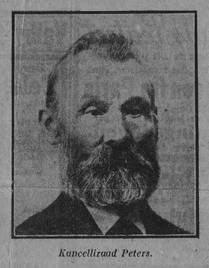
- Et gammelt avisfoto fra Berlingske Tidende av den danske lærer og kanseliråd, J. A. Peters, 1835-1924, som også konstruerte en skrivemaskin
Spørgsmaalet kunde synes mærkeligt efter foranstaaende, og før 1921 var det da ogsaa utænkeligt. Men i Berlingske Tidende for 12. Novbr. nævnte Aar fremkom Professor H. I. Hannover med en Artikel, hvori han fremsette den Paastand, at den den gang nylig afdøde Kancelliraad, tidligere Lærer i Flensborg, J. A. Peters, var den virkelige Opfinder af Skrivekuglen.
Paastanden overraskede vistnok alle – og ikke mindst Malling Hansens nulevende Døtre. Der opstod en Polemikk mellem dem og Professoren, en Polemikk, der til Tider antog temmelig skarpe Former.
Det vilde føre for vidt paa dette Sted at komme ind paa Enkelthederne i Diskussionen, men Spørgsmaalet er dog af saa stor Betydning, at det kort skal omtales. [1]
Professoren var naaet til sin Slutning efter at Historisk Teknologisk Samling havde erhvervet en ”skrivekuglelignende” Overdel, som var lavet af Kancelliraad Peters, og efter at han havde haft en Samtale med denne, under hvilken han var naaet til det Resultat, at Peters havde opfundet Skrivekuglen endog flere Aar før Malling Hansen, hva der blev bekræftet af Peter.
Peter’s Maskine staar omtalt i Illustrierte Zeitung for 12. Oktober 1872 som opfundet i 1868; men Maskinen fra 1868 staar beskreven samme Aar i Berlingske Tidende, og de to Beskrivelser stemmer ingenlunde overens. I Berlingske Tidende omtales den som ”havende Form som et middelstort rundt Bord og i det ydre lignende de saakaldte taffelformede Pianoforter.”
Billedet fra Illustrierte Zeitung viser derimod en Genstand, der nærmest ligner de saakaldte ”Urtepotteskjulere”, en meget mindre, men sikkert meget mer praktisk Modell, der kun har Vægtstangprincippet tilfælles med den fra 1868, men i sig selv er en helt ny Konstruktion fra 1871. Peters har – og derved blev han opfattet som den første – overfor Illustrierte Zeitung fortiet, at den indleverede Modell var ny. Redaktionen har saa formodet at det var Modellen fra 1868.
Ydermere maa det tilføjes, at Peters overhovedet ikke har faaet Patent paa nogen Maskine i 1868, Patentretten fik han først i Begyndelsen af 1872.
Artiklen i Ill. Zeitung er saaledes i høj Grad urigtig, der kan intet bygges paa den, og ovenstaaende Spørgsmaal maa efter som før 1924 besvares med et ubetinget Ja.
Under Striden om ovenstaaende Spørgsmaal udtalte Professor Hannover sig iøvrigt ret nedsættende om Skriften fra Malling Hansens Skrivekugle, idet han erklærede, at Bogstaverne var tværet du. Af hosstaaende Skriftprøver kan man imidlertid selv danne sig et Skøn. – For øvrig henvendte Fru Engelke Wiberg, f. Malling Hansen sig, for at faa en sagkyndig Dom, til Formanden for Importører af Skrivemaskiner i Danmark, og modtog følgende Svar:
Foreningen skal udtale, [2] ”at deres (Skriftprøvernes Kvalitet efeter vor Formening er meget fin og fuldtud staar på Højde med, hva moderne Skrivemaskiner nu til Dags kan præstere i Henseende til smuk og tydelig Skrift.”
Malling Hansens Skrivekugle kunde aabenbart paa dette Omraade udmærket konkurrerer med de nutildags gangbare Mærker.
[1] Skulde nogen ønske nærmere at sætte sig ind i Sagen henvises der til Fru Johanne Agerskov, f. Malling Hansens Skrift ”Hvem er Skrivekuglens Opfinder?”
[2] Svaret er dateret 20. December 1924 og underskrevet F. C. Larsen, Formand.
Biologiske Studier.
Ogsaa som Biolog naaede Malling Hansen frem i allerførste Række. Hans videnskabelige Værk: ”Perioder i Børns Væxt og i Solens Varme”, blev kendt over hele Europa og har sit Udspring i en praktisk og ganske prosaisk Undersøgelse over det bedste Spisereglement for Døvstummeinstitutet. Denne Undersøgelse førte ham ind paa at foretage forskellige Vejninger af Børnene, og hvor grundig han gikk til Værks, faar man et Indtryk af ved at lese i ovennævnte Værk: ”Eleverne vejes fire Gange om dagen hele Aaret rundt, undtagen i Tiden fra Midten af Juli til henimod Slutningen af August, da Børnene i Sommerferien er borte fra Institutet. Sidste Vejning af Drengene foregaar hver Aften Kl. 9 med Undtagelse af Juni-Juli, da Vejningen sker Kl. 9 1/2 . Drengene var tidligere inddelt i otte faste Grupper, nu kun i fire, hver paa en 16-18 Børn.” Vejningen af hver Gruppe tog c. 15 Sekunder og foretoges i de første 8 Maaneder af Malling Hansen selv, efter den Tid fordeltes Aftenvejningen mellem 5 af Institutets Lærere. De fortsattes i c. 4 Aar, og skulde der nu paa Basis af disse Vejninger bygges en almindelig Regel for Børns Vægtudvikling gennem et Aar, saa maatte den komme til at lyde saaledes:
En ni til femten Aar gammel Drengs Vægtforhold gennemgaar hvert Aar tre Hovedperioder, en Maximums-, en Mellem- og en Minimumsperiode. Maximumsperioden begynder i August og ender midt i December, varer altsaa 4 ½ Maaned. Mellemperioden rækker fra midt i December til Udgangen af April, 4 ½ Maaned. Minimumsperioden gaar fra Slutningen af April til Slutningen af Juli, 3 Maaneder. I Maximumsperioden er den daglige Vægtudvikling 3 Gange saa stor som i Mellemperioden. Næsten hele den i Mellemperioden indvundne Vægtforøgelse tabes i Minimumsperioden.
Ogsaa børnenes Højder var Genstand for Iagttagelse, idet de blev maalt en Gang om Dagen, og Resultatet af disse Maalinger var følgende:
En ni til femten Aar gammel Drengs Længde-Væxt gennemgaar hvert Aar 3 Hovedperioder, en Minimums-n en Mellem- og en Maximumsperiode. Minimumsperioden begynder i August og varer til henimod Slutningen af November, c. 3 ½ Maaned. Mellemperioden gaar fra Slutningen af November, til henimod Udgangen af Amrts, varer altsaa c. 4 Maaneder. Maximumsperioden rækker fra Udgangen af Merts til ind i Midten af August og omfatter altsaa c. 4 ½ Maaned. Den daglige Højdevæxt er i Mellemperioden dobbelt saa stor som i Minimumsperioden og i Maximumsperioden 2 ½ Gang saa stor. Perioderne i saavel Børnenes Højde- som Tykkelsesvæxt er uafhengig af deres Ernæring og Beskæftigelse.
Fra Børnene vendte Malling Hansen sig til Træerne i Institutets Have og fandt ved taltige Maalinger, at Forholdet mellem Træernes Længde- og Tykkelsesvæxt har væsentlige Lighede med samme Væxtperioder hos Børnene.
Længdevæxtens Maximumstid efterfølges af Tykkelsesvæxtens Maximumstid; under Længdevæxten er der væsentlig Hviletid for Tykkelsesvæxten og omvendt.
Hans Studier fikk ikke alene Betydning for Fysiologien, men ogsaa for Meteorologien og Astronomien. Gennem en Række skarpsindige og geniale Undersøgelser fandt han, at ovennævnte Perioder i Børnenes Væxt og Vægt skyldes kosmisk Indvirkning, ja, at alle organiske Funktioner paa Jorden er i uafbrudte og samstemmende Intensitetssvingninger, til hvilke Impulserne udgaar fra Solen, idet de kommer i eller med dennes Varmestraaler.
Han naaede ved disse Undersøgelser den smukkeste Anerkendelse, der kan tænkes. Paa en Lægekongres i København holdt han – de døvstummes Lærer og Præst – et Foredrag om Perioder i Børns Væxt, og alle Lægevidenskabens Ypperste hilste ham med udelt Bifald, ligesom han ved sin Død i Udlandets Presse betegnedes som en af Biologiens betydelige Forskere.
Af det foregaaende faar man, som naar man ellers studerer Malling Hansens liv, Indtrykket af en Mand, der havde Øjnene med sig paa alle Omraader, gikk stille og iagttog, og ikke saa nogen Virkning uden at forske efter Aarsagerne og bearbejde sine Iagttagelser i sig selv ved en stille Proces, indtil de havde antaget fast Form. Saa kastede han sig med overordentlig Iver over de Enkeltheder, som yderligere skulde klare, oplyse og bevise hans Ideer, opsamlede Kendsgerninger i Hobevis fra de forskelligste Sider, forfulgte Maalet Aar du og Aar ind med utrættelig Iver og begyndte langsomt at opføre den Bygning fra Grunden af, hvis Kuppel han i Fantasien saa rage højt til Vejrs.
Naturen havde skænket ham sjældne Gaver, noget af den intuitive Kraft, der er Geni, Lethed til at sætte sig ind i Videnskabens forskellige Grene, Koldblodighed og Ro og en egen fin Sporsans.
Trods sine mange Skuffelser var Malling Hansen en udpræget ”Lysseer”. Han var meget indadvendt, men kunde dog ogsaa være livlig og munter, han var overordentlig musikalsk, og blev i høj Grad beundret for sit Orgelspil.
Han kunde glæde sig over andres Glæde og være overmaade hjælpsom. Han var f. Ex. Til stor Støtte for Ingeniør Voigt, der i mange Aar tumlede med Planer til en styrbar Ballon, blant annet hjalp han ham med en Del mathematiske Beregninger og Konstruktioner.
Det var paa hans Opfordring og Tilskyndelse, at Ludvig Feilberg i sin Tid udgav sine filosofiske Værker. Malling Hansen saa klart, at Feilbergs selvstændige Tanker og Ideer var meget betydningsfulde.
Som et lille Kuriosum kan ogsaa nævnes, at det var Malling Hansen, der først fremkom med den teori, at Aarsagen til de overordentlig skønne og farveprægtige Solnedgange, der viste sig i Aarene 1883-84, maatte ligge i den voldsomme Askeregn, som i vide Kredse blev udslynget ved Vulkanen Krakatoas Udbrud. Solstraalernes Brydning i Atmosfærens Askelag, mente han, gav de skønne Farver til Solens Nedgang, en Teori, som Videnskabsmændene senere accepterede.
I et lille Samfund som vort er Betingelserne ikke gunstige for Udviklingen af ”Heroer”, skønt Aarsagerne vistnok ligger andetsteds og dybere end i den blotte Lidenhed. Det er med Rette bleven bemærket om vore Stormænd i Politikens, Kunstens og Aandens Rige, at det saa godt som aldrig lykkes dem at naa det højeste, de er ”nær ved”, ”paa Nippet til”, men heller ikke mer.
Malling Hansen danner ingen Undtagelse fra denne Regel. Han høstede ingen anden Frugt end Skuffelse af sin Skrivemaskine, og det lykkedes ham ikke at skaffe den Indpass i vide Kredse, verken i eller udenfor vort Fædreland. Han lagde Grunden til en ny videnskabelig Metode og anviste Veje, ad hvilke hans Efterfølgere kunde gaa, men selv kom han kun et kort Stykke ad dem.
En Videnskabens Pioner, det er det Navn, der tilkommer ham med Ære, men det udtømmer ingenlunde hans Væsen, thi han var mer end det.
Vi maa ikke glemme, at han var en Fader for de ulykkelige Børn, der betroedes til hans Omsorg, en sand Menneskeven og en god Mand.
Data.
Født 5. Septbr. 1835. Eksamen fra Jonstrup Seminarium 1854. Hjælpelærer i Maglemer ved Saxkjøbing 1 Aar, fra den 1. Juli 1854. Den 10. Jan. 1859 Lærer ved det kongelige Døvstumme-Institut i København. 1. Oktbr. 1861 paa Regensen. 1. Oktbr. 1862 Lærer ved det kongelige Døvstumme-Institut i Slesvig By. 23. April 1863-Febr. 1864 Forstander sammesteds.
Cand. Theol. 27. Juni 1865. Samme Aar Forstander og Førstelærer ved det kongelige Døvstumme-Institut i København og 1. Septbr. Samme Aar tillige Præst sammesteds.
31. Mai 1872 Fortjenstmedaillen i Guld. Modtog 1873 for Opfindelsen af Skrivekuglen den østerrigske Guldmedaille ”pro literis et artibus”. Ved Verdensudstillingen i Wien samme Aar”Fortschritts-Medaille”. Paa den nordiske Udstilling 1875 1. Medaille. 26. Juni 1876 Ridder af den svenske Vasaorden. Udstillingen i Paris 1878 Guldmedaille og 2. Febr. 1880 Ridder af Dannebrog. 1882 Underdirektør ved det kongelige Døvstumme-Institut i Fredericia. Død 27. Septbr. 1890.
Gift: 1. Gang 1865 med Cathrine Georgia Heiberg. Datter af Professor Søren H., Præst og Forstander ved det kongelige Døvstumme-Institut. (Malling Hansens Forgænger). I dette Ægteskab var der 7 Børn, som Moderen døde fra 1876.
2. Gang 1880 med Anna Cathrine Maria Stenstrup, Datter af By- og Herredsfogd i Frederikshavn, Michael Vogelius Stenstrup Død 1897.
Dessverre har vi ingen informasjon om artikkelforfatteren, Arild S Ebbe, men Malling-Hansens datter, Johanne Agerskov, etterlot seg et brev hun mottok fra Ebbe. Brevet er datert 27/6-28, og lyder:
Fru Johanne Agerskov, født Malling-Hansen.
Med mange Tak for Laan tilbagesender jeg vedlagte, jeg haaber og tror at hva jeg har laant er kommet med tilbage med Undtagelse jo af Deres Bog ”Hvem er Skrivekuglens Opf.?” som De var saa venlig at forære mig. Jeg takker Dem samtidig for al Hjælp under Udarbejdelsen af Artiklen i Jonstrupbogen, som jeg sender Dem et Ekspl. Af. Bogen er et Aarsskrift for gamle Jonstruppere.
Venlig Hilsen Deres ærbødige Arild S. Ebbe

